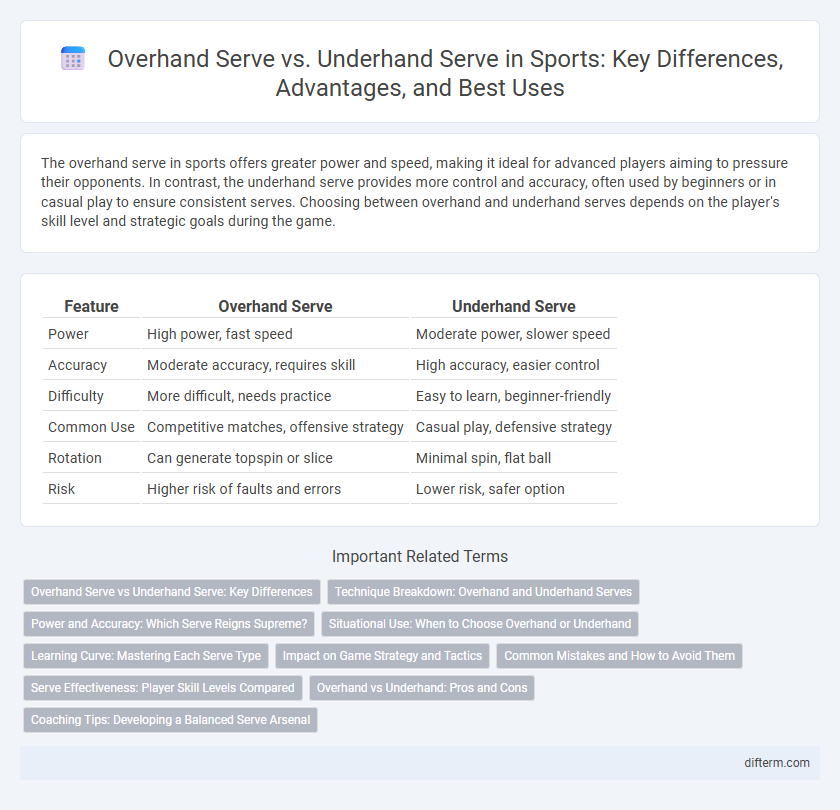The overhand serve in sports offers greater power and speed, making it ideal for advanced players aiming to pressure their opponents. In contrast, the underhand serve provides more control and accuracy, often used by beginners or in casual play to ensure consistent serves. Choosing between overhand and underhand serves depends on the player's skill level and strategic goals during the game.
Table of Comparison
| Feature | Overhand Serve | Underhand Serve |
|---|---|---|
| Power | High power, fast speed | Moderate power, slower speed |
| Accuracy | Moderate accuracy, requires skill | High accuracy, easier control |
| Difficulty | More difficult, needs practice | Easy to learn, beginner-friendly |
| Common Use | Competitive matches, offensive strategy | Casual play, defensive strategy |
| Rotation | Can generate topspin or slice | Minimal spin, flat ball |
| Risk | Higher risk of faults and errors | Lower risk, safer option |
Overhand Serve vs Underhand Serve: Key Differences
Overhand serve and underhand serve differ primarily in technique and effectiveness; overhand serves generate greater power and speed, making them ideal for competitive play, while underhand serves offer more control and are easier for beginners. The overhand serve uses an overhead arm motion with a ball toss, allowing for topspin or flat serves, whereas the underhand serve involves swinging the arm beneath the waist, resulting in a slower, more predictable trajectory. Selecting between overhand and underhand serves depends on player skill level, desired serve speed, and match strategy in sports such as volleyball and tennis.
Technique Breakdown: Overhand and Underhand Serves
Overhand serves generate more power and speed by utilizing a high toss and a snapping wrist motion, making them effective for aggressive play and difficult returns. Underhand serves rely on a smooth, low-to-high swing, emphasizing control and accuracy, often used for strategic placement or to disrupt the opponent's rhythm. Mastery of body positioning, arm swing mechanics, and timing are crucial for maximizing effectiveness in both serve techniques.
Power and Accuracy: Which Serve Reigns Supreme?
Overhand serves generate more power due to increased arm speed and body momentum, making them the preferred choice for advanced players seeking to dominate rallies. Underhand serves offer greater accuracy and consistency, ideal for beginners aiming to place the ball strategically with minimal risk. Power and precision ultimately depend on skill level, but competitive matches often favor overhand serves for their ability to combine velocity with targeted placement.
Situational Use: When to Choose Overhand or Underhand
Overhand serves are ideal for aggressive play and scoring points due to their speed and spin, making them suitable in competitive matches or when aiming to pressure the opponent. Underhand serves offer greater control and consistency, often chosen by beginners or in casual games to maintain rally flow or exploit opponents' weaknesses in receiving. Selecting between overhand and underhand serves depends on the player's skill level, tactical goals, and the match context, such as opponent positioning and fatigue.
Learning Curve: Mastering Each Serve Type
The overhand serve requires more advanced coordination and timing, creating a steeper learning curve compared to the underhand serve, which is typically easier for beginners to grasp. Developing power and accuracy in the overhand serve demands consistent practice and refined technique, while the underhand serve emphasizes control and placement, making it a strategic choice during early training stages. Mastery of the overhand serve often leads to greater offensive advantages in volleyball and tennis due to increased speed and spin potential.
Impact on Game Strategy and Tactics
The overhand serve in volleyball creates a faster, more aggressive attack opportunity, forcing opponents into a defensive posture and enabling strategic positioning for quick kills. The underhand serve provides greater control and accuracy, making it ideal for targeting weaker passers and disrupting the opponent's formation. Teams often use overhand serves to apply pressure and dictate pace, while underhand serves serve as a tactical choice to maintain consistency and reduce service errors.
Common Mistakes and How to Avoid Them
Common mistakes in overhand serves include improper ball toss and lack of wrist snap, leading to poor control and reduced power. Underhand serve errors often involve incorrect paddle angle and insufficient follow-through, resulting in inconsistent ball placement. To avoid these mistakes, players should practice consistent toss positioning for overhand serves and maintain a relaxed but firm grip with proper swing mechanics for underhand serves.
Serve Effectiveness: Player Skill Levels Compared
Overhand serves generate higher ball velocity and spin, making them more effective for advanced players who can control precision and power. Underhand serves provide consistency and accuracy, favored by beginners due to easier technique and reduced error rates. Skill level directly influences serve choice, with advanced athletes leveraging overhand serves for competitive advantage while novices often rely on underhand serves to maintain rallies.
Overhand vs Underhand: Pros and Cons
Overhand serves generate higher speed and more spin, enhancing offensive play and making it harder for opponents to return, but they demand advanced technique and greater physical effort. Underhand serves offer better control and are easier to master, reducing the risk of faults, though they lack power and can be predictable for experienced players. Choosing between overhand and underhand serves depends on skill level, strategic goals, and game context in sports like volleyball and tennis.
Coaching Tips: Developing a Balanced Serve Arsenal
Coaching tips for developing a balanced serve arsenal emphasize mastering both overhand and underhand serves to enhance game versatility and unpredictability. Focus on refining the overhand serve for power and accuracy, while incorporating the underhand serve to surprise opponents and maintain consistency under pressure. Balanced practice routines that alternate between these techniques improve overall serving effectiveness and adaptability in various match situations.
overhand serve vs underhand serve Infographic

 difterm.com
difterm.com